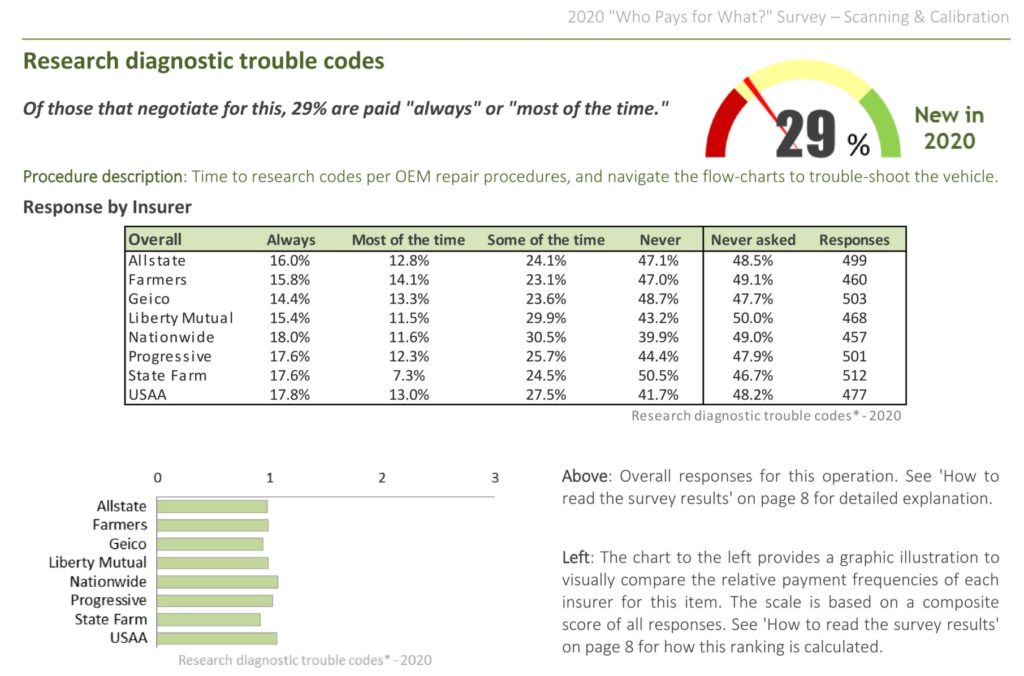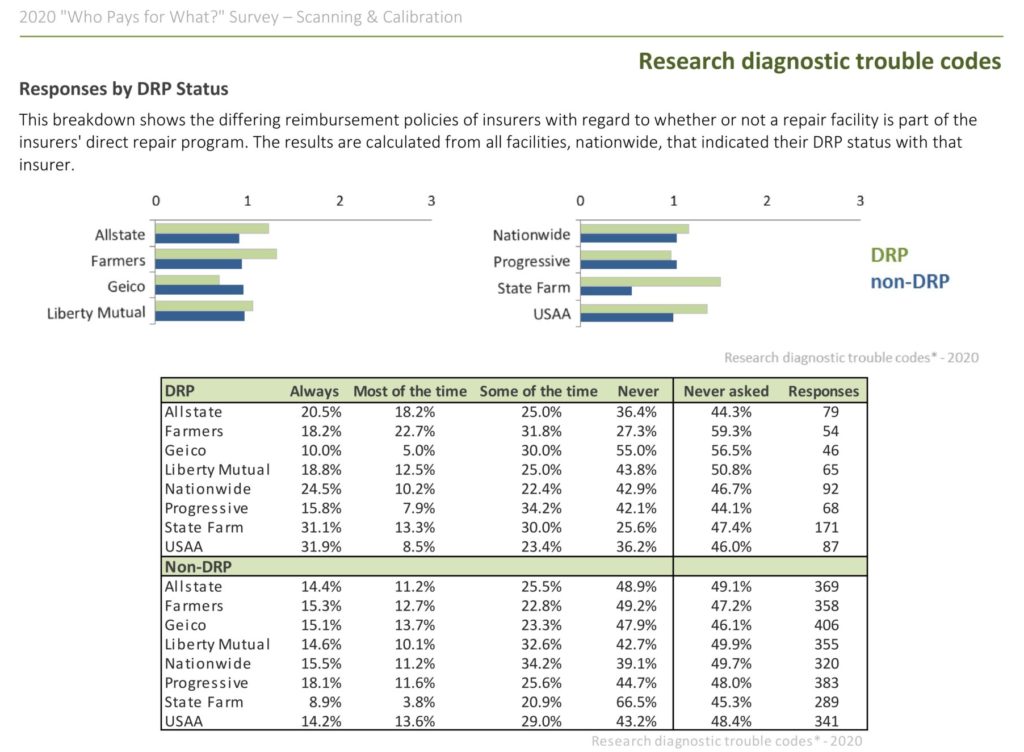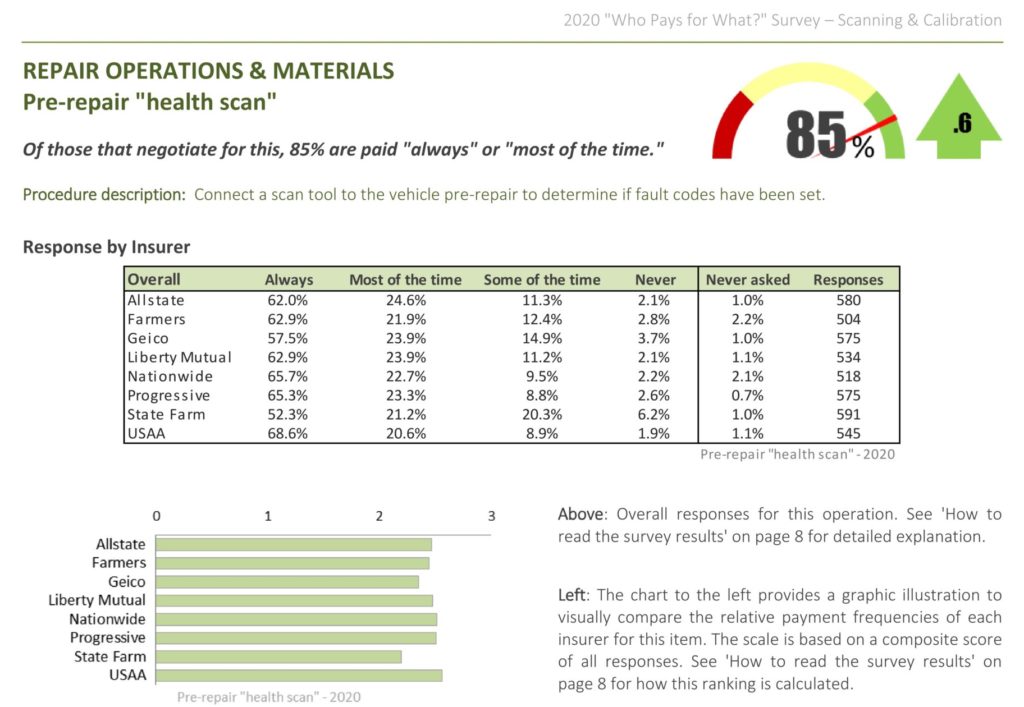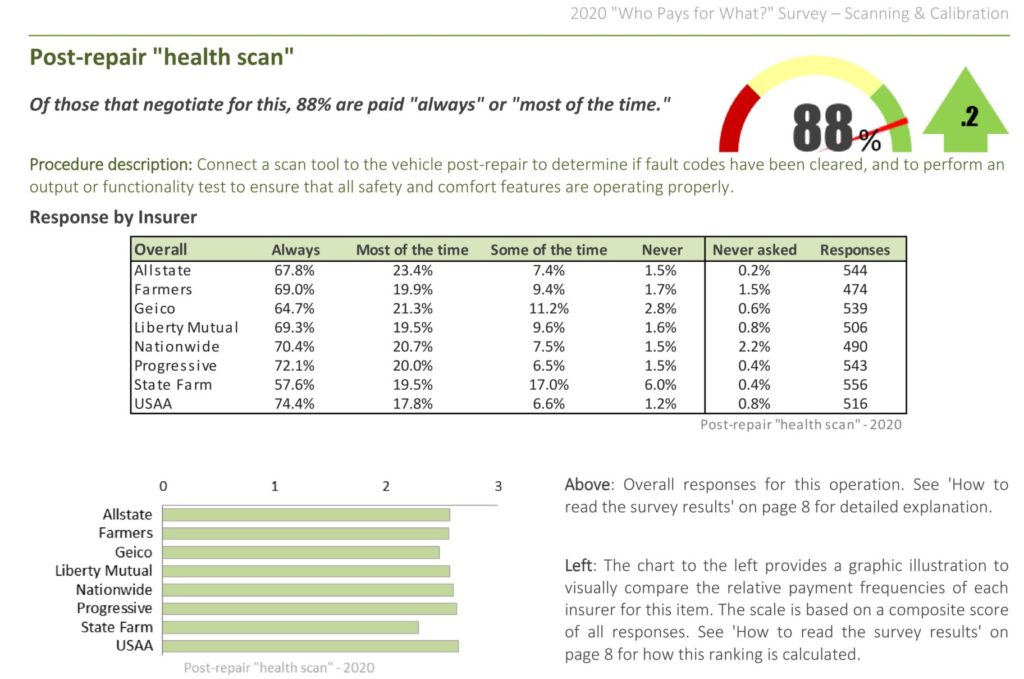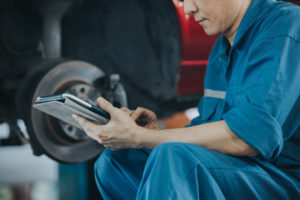
‘Who Pays?’: 39% of body shops itemize diagnostic research separately than scans
By onBusiness Practices | Insurance | Market Trends | Repair Operations | Technology
Nearly 40 percent of collision repairers itemize time spent researching diagnostic trouble codes rather than bundling this labor in their scanning time, according to the latest “Who Pays for What?” survey.
The October 2020 poll saw 61 percent of auto body shops indicating their bills’ scanning line item would have included DTC research efforts. The other 39 percent of the unspecified number of respondents would have drawn a distinction between the work and itemized the two processes separately.
Collision Advice CEO Mike Anderson, whose company conducts the survey in conjunction with CRASH Network, on Monday made a case for itemizing diagnostic research separately than scan labor.
“I know first-hand how much time it takes to research and troubleshoot DTCs,” Anderson said in a statement. “Diagnostic labor time should really be separated from the scan labor time because there are just too many variables involved. Just as judgement times vary based on the size and location of the damage and the substrate involved, diagnostic time varies as well. Isn’t the time it takes to research one diagnostic trouble code different from researching five? And it’s not just looking up the code. You also have to navigate the OEM repair flowchart to determine what the most probable cause is. If there are several possible causes, it might be the first one you try, or the last one. All this takes time.”
A separate question on the October 2020 “Who Pays?” asked shops how frequently eight top insurers reimbursed a charge for researching DTCs, defined as “Time to research codes per OEM repair procedures, and navigate the flow-charts to trouble-shoot the vehicle.”
Only 29 percent of the few hundred responding shops reported having their bill covered by the carriers “always” or “most of the time.” (Technically, shops are billing customers, who then seek reimbursement from insurers.)
Around 50 percent of the shops polled said they never asked, which Anderson suggested meant the work was being done for free rather than covered with a scanning time which had been expanded accordingly.
“I would expect the percentage of shops billing and being paid regularly for this is to grow in 2021 as the industry becomes more educated,” Anderson wrote in the “Who Pays?” report. “Note how many shops indicated they have never sought to be paid for this process.”
Large percentages of the shops who did bill for researching DTCs reported insurers who “never” covered those charges, with State Farm, GEICO, Allstate and Farmers around a 50 percent “never” rate. (The margin of error was 3.8 percent, assuming all 667 shops in a 40,000-shop industry responded.)
State Farm was interesting in that it was overwhelmingly more likely to consistently cover diagnostic research when a DRP shop billed a customer for it than when a non-DRP shop did. The spread between its treatment of the two groups of repairers stood out compared to the other five carriers that were more likely to consistently reimburse network body shops.
All of the eight major insurers were extremely likely to cover pre- and post-repair scans, however. Collision Advice and CRASH Network defined these as connecting a scan tool to determine if fault codes existed. The researchers also defined a post-repair scan as encompassing “an output or functionality test to ensure that all safety and comfort features are operating properly.”
85 percent of shops reported the insurers covering pre-repair scans “always” or “most of the time” and 88 percent of shops encountered those responses on post-scans.
“It’s encouraging to see this has continued to go up,” Anderson wrote of post-scans in the report. “I think it’s important to understand that there are not dash lights for every function that may not be working on a vehicle. Some vehicles need to be driven a certain distance or have a set number of key cycles before a dash light is triggered. So the post-repair scan has to be done to ensure all the safety and comfort features of the vehicle are working properly. There is no dash warning light, for example, that tells you the Bluetooth feature isn’t working. There may be no dash light for blind-spot monitoring or adaptive cruise control. So I look forward to the day when post-repair scans are being paid 100 percent.
“Whether scanning is done in-house or through a sublet service, I encourage shops to capture the ‘freeze frame’ or ‘snapshot’ data (which shows when trouble codes were set, or how many times the keys have been turned on/off since the code was set) as documentation to substantiate the line item(s) on the estimate or invoice.”
“It’s also interesting to note that there are very few shops NOT seeking to be paid for post-repair scanning,” Anderson wrote. “This is different from some of the other procedures where a significant percentage of shops aren’t getting paid because they’re not seeking to be paid. In this case, when shops aren’t being paid, it’s generally because of friction from the insurance carriers. But also remember that an insurer refusing to pay for a post-repair scan does not remove your shop’s liability for not conducting a scan.”
Help the collision industry by taking the current “Who Pays for What?” survey by the end of the month and answering questions on topics like refinishing. All answers are kept confidential; data is published only in the aggregate.
More information:
CRASH Network and Collision Network, Jan. 4, 2021
Take the anonymous first-quarter “Who Pays?” survey
Images:
Some collision repairers itemize time spent researching diagnostic trouble codes separately than their time performing diagnostic scans. (Erdark/iStock)
Nearly 40 percent of collision repairers itemize time spent researching diagnostic trouble codes rather than bundling this labor in their scanning time, according to the latest “Who Pays for What?” survey. The study was conducted in October 2020. (Provided by Collision Advice and CRASH Network)
An October 2020 “Who Pays for What?” question asked body shops how frequently eight top insurers reimbursed a charge for researching DTCs, defined as “Time to research codes per OEM repair procedures, and navigate the flow-charts to trouble-shoot the vehicle.” Only 29 percent of the few hundred responding shops reported having their bill covered by the carriers “always” or “most of the time.” (Provided by Collision Advice and CRASH Network)
85 percent of shops responding to an October 2020 “Who Pays for What?” survey question reported the insurers covering pre-repair scans “always” or “most of the time.” (Provided by Collision Advice and CRASH Network)
88 percent of shops responding to an October 2020 “Who Pays for What?” survey question reported the insurers covering pre-repair scans “always” or “most of the time.” (Provided by Collision Advice and CRASH Network)


